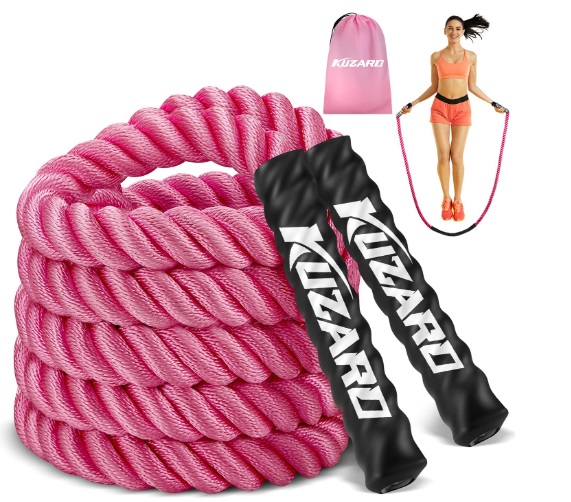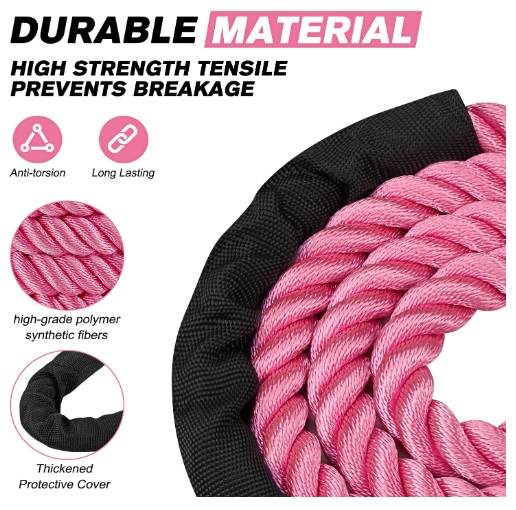
Weighted Jump Rope review
Click Picture and Video & Price & More
Jumping rope has long been a staple in fitness routines, thanks to its efficiency in burning calories, improving coordination, and boosting cardiovascular health. However, in recent years, weighted jump ropes have gained traction as an advanced tool for fitness enthusiasts looking to push their limits. This review explores the benefits, potential drawbacks, and key considerations of using weighted jump ropes.
What is Weighted Jump Rope review
A weighted jump rope is essentially a jump rope with added weight, either in the handles or the rope itself. Unlike traditional jump ropes, which emphasize speed and rhythm, weighted versions offer greater resistance. The added resistance forces the muscles to engage more intensely, especially in the arms, shoulders, and core. As a result, weighted jump ropes not only improve cardiovascular endurance but also contribute to strength training.

Click Picture and Video & Price & More
Key Benefits of Using a Weighted Jump Rope review
1. Enhanced Caloric Burn
Firstly, the increased weight leads to more effort being exerted, which in turn burns more calories. Studies indicate that jumping rope is already one of the most efficient exercises for calorie-burning. When resistance is added, the body works even harder, leading to faster fat loss.
2. Improved Strength and Endurance
Additionally, one of the primary advantages of weighted jump ropes is their ability to target multiple muscle groups simultaneously. The arms, shoulders, core, and legs must work in harmony, which helps build both muscular endurance and strength.
3. Better Coordination and Agility
Furthermore, weighted jump ropes promote neuromuscular coordination, requiring more focus and precision to maintain rhythm. Over time, this improves agility and balance, making the exercise beneficial for athletes and those in sports that demand quick reflexes.
4. Versatile Workout Option
Not only is the weighted jump rope an excellent tool for cardio and strength workouts, but it is also highly portable. As a result, it fits seamlessly into home workouts, gym routines, or even outdoor exercises, providing users with multiple options for use.
Potential Drawbacks to Consider
Despite the numerous benefits, there are some limitations and risks associated with weighted jump ropes.
1. Risk of Injury for Beginners
For beginners, the added weight may increase the risk of injury. Improper technique can place excessive strain on the wrists, shoulders, and lower back. Hence, starting with a lighter rope and gradually increasing weight is recommended to avoid injuries.
2. Fatigue and Recovery Issues
Moreover, because weighted jump ropes demand more from the muscles, fatigue can set in quickly. This may lead to overexertion if not managed properly. It is essential to include rest days and adequate recovery in the workout schedule.
3. Higher Learning Curve
While traditional jump rope exercises are relatively easy to learn, weighted jump ropes require more skill and control. Therefore, beginners may find it challenging at first and should start slowly to build confidence and coordination.
How to Choose the Right Weighted Jump Rope
When selecting a weighted jump rope, several factors must be taken into account.
Weight: For beginners, a rope with lighter weight (1/4 to 1/2 lb) is preferable. Advanced users can opt for heavier ropes (up to 2 lbs or more) to intensify their workouts.
Length: The length of the rope should suit the user’s height to ensure smooth movement. In general, when standing on the middle of the rope, the handles should reach the armpit level.
Handle Design: Comfortable and ergonomic handles with non-slip grips are important to prevent fatigue during extended workouts.
Rope Material: Weighted ropes are available in materials such as PVC, leather, or steel cable. Depending on the workout environment—indoor or outdoor—users can select the material that best suits their needs.
Incorporating Weighted Jump Rope into Your Routine
Incorporating a weighted jump rope into your routine is straightforward, but progression is key. Initially, short intervals of 30 seconds to 1 minute are advisable. As coordination and endurance improve, the duration and intensity can be increased. Weighted jump rope exercises can also be combined with other movements like squats, lunges, and burpees for a full-body workout.
Conclusion
In summary, weighted jump ropes offer an excellent way to elevate both cardio and strength workouts. With benefits such as improved endurance, better coordination, and a higher caloric burn, it’s no surprise that this fitness tool is gaining popularity. However, it is important to use proper technique and progress gradually to avoid injuries. For fitness enthusiasts seeking a new challenge or anyone wanting to upgrade their traditional cardio routine, the weighted jump rope is certainly worth trying. As with any workout tool, consistency and proper usage are key to reaping the full benefits.
More review: Chair Yoga for Weight Loss